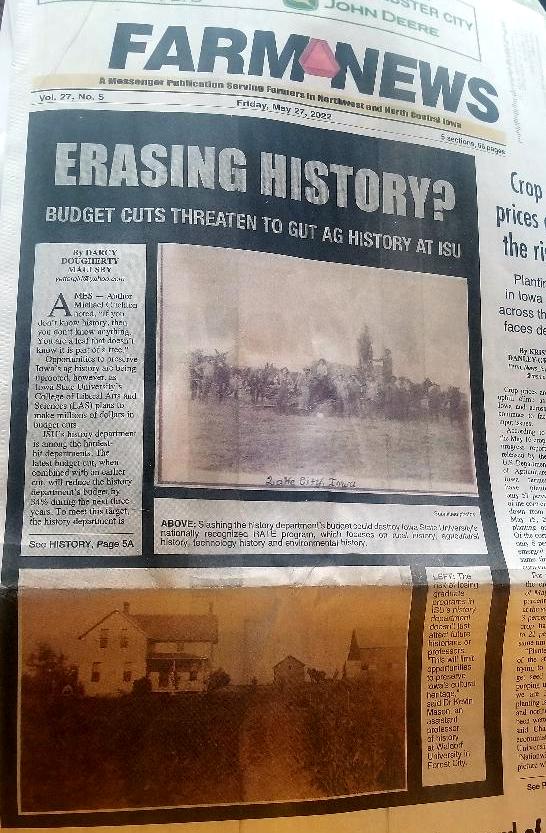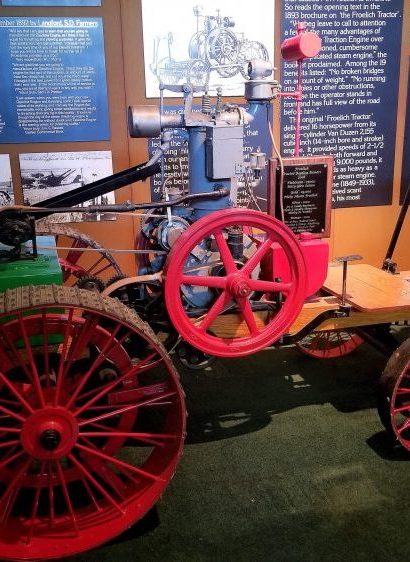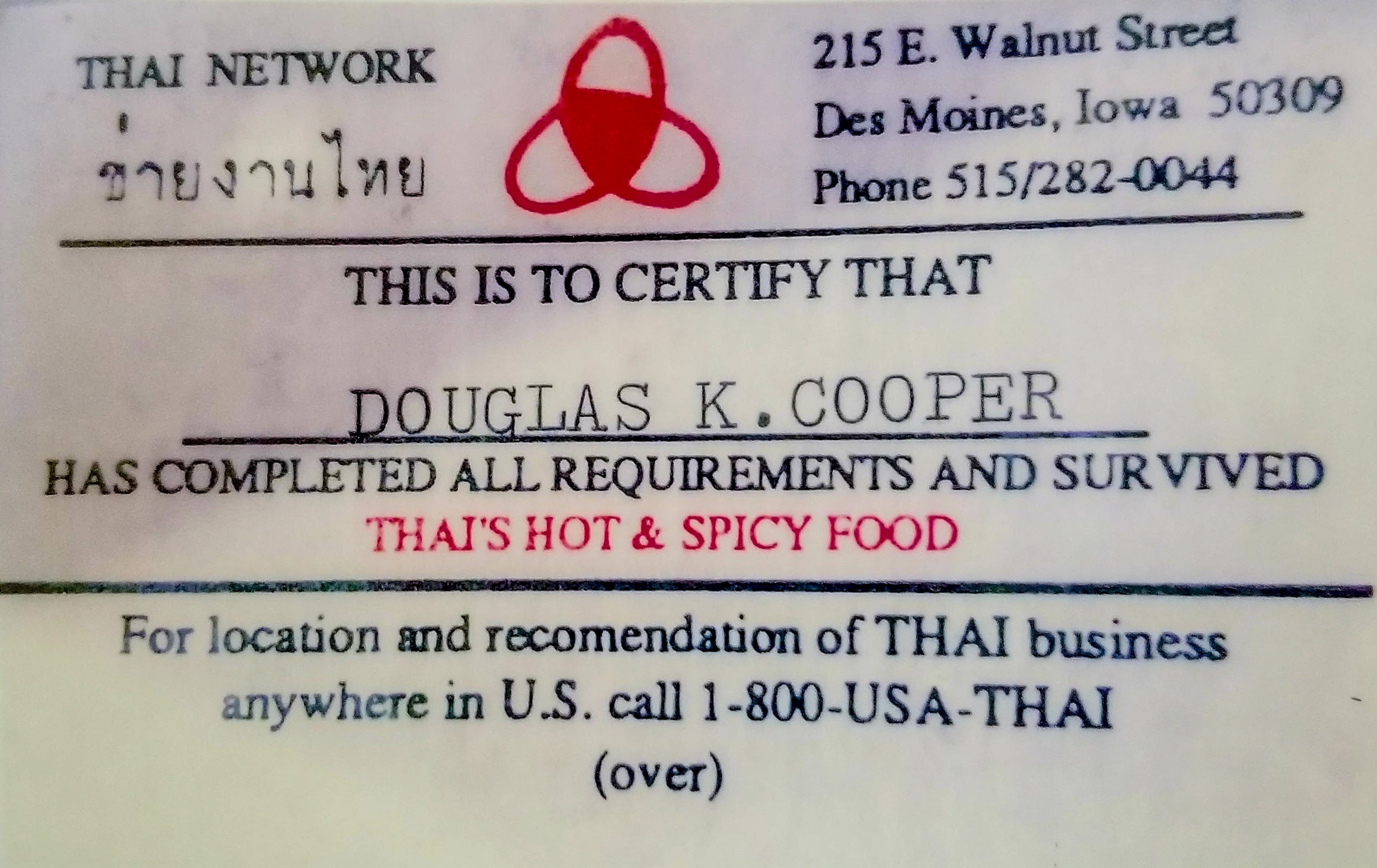
Whats HOT
Latest Posts
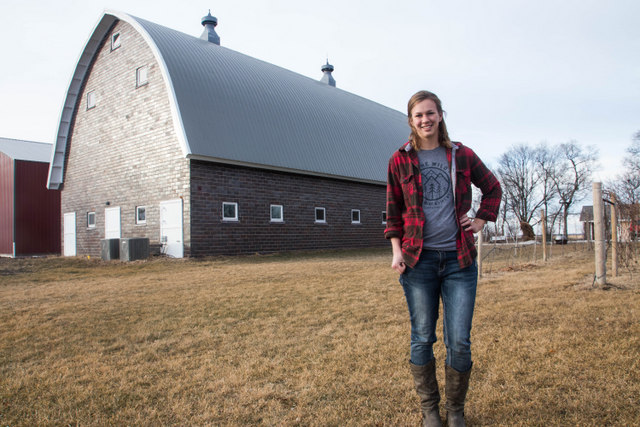
Events Spark Stories That Help Backcountry Winery Grow in Iowa
Ask Amber Gable about the back story behind Backcountry Winery at her family’s home east of Stratford, and her answer is straightforward. “It’s a hobby out of control.”
That hobby has taken Gable and her husband, Preston, on dynamic journey that has led to the creation of a small business that’s helping spur economic development in rural Iowa. At the heart of it all is a century-old barn that’s central to the story, offering an attractive venue for gatherings, celebrations, music concerts and more.
“This barn is such a unique building,” said Amber Gable, 27, who grew up on a farm near Sibley. “There’s so much history here, including original interior boards that have Stratford Grain and Supply stamped on them.”
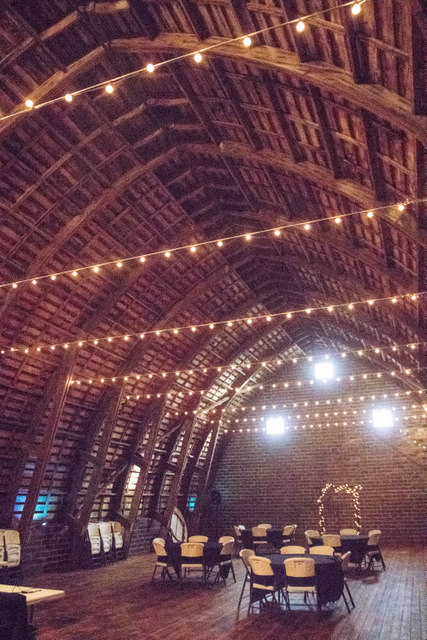
Beyond the tasting room on the main floor, the barn loft holds 150 people.
Guests who come to Backcountry Winery for bridal showers, wedding receptions, class reunions and other celebrations enjoy exploring this rural heritage. So do the visitors who stop by for Backcountry Winery’s live music events.
“When we’re open on Saturday afternoons without a special event like live music, we tend to have smaller crowds,” Gable said. “Events help create experiences that people seek out.”
Events of all types have become an increasingly important part of running a successful winery, noted Mike White, a viticulture specialist for Iowa State University Extension. “More wineries are realizing that there’s big potential in event centers, and many are going this way.”
Putting down roots in Hamilton County
For many guests, part of the experience involves learning the story of the winery. In the case of Backcountry Winery, that story began with Preston Gable’s long-time interest in home winemaking.
“We’d talk about how we might open a winery someday,” said Amber Gable, whose husband is a fellow northwest Iowa native from Hartley.
“Someday” seemed far off, however, when the high school sweethearts started their careers in Ames following their graduation from Iowa State University (ISU). Amber Gable became a landscape designer for an engineering firm, while her husband worked in biofuels research at ISU.
When the couple began looking for an affordable acreage in central Iowa where they could establish a home, start a family and maybe operate a winery eventually, the process became frustrating at times. “We actively looked for about a year and often came up with nothing,” Amber Gable said. “There were some tears along the way.”
Things turned around in 2014, though, when the young couple found an acreage with a house and barn northeast of Stratford. “We really needed a fixer-upper, and this place needed a family to put down roots,” Amber Gable said.
After the couple purchased the property in August 2014, they began remodeling the barn within a few months and exploring its history. The abstract for the property goes back to 1920, when the current home on the acreage was built by Alfred Erickson. “We know the barn pre-dates 1920, although we don’t know exactly when it was built,” Amber Gable said.
While the barn is structurally sound, time had taken a toll on some parts of the building. “We poured a new concrete floor and replaced the entire hayloft floor,” said Amber Gable, who noted that the barn once housed cattle.
After months of work, the Gables opened Backcountry Winery in May 2016. “The barn is still a work in progress, but it has allowed us to open our winery sooner than we anticipated,” said Amber Gable, who appreciates the opportunity to run a home-based business, especially now that she and her husband are raising their 1-year-old son, Ivan.
Word-of-mouth marketing, Backcountry Winery’s website and a Facebook page have helped the couple’s business grow. While Backcountry Winery hosted one wedding in 2016, this grew to five weddings in 2017 and has increased to seven weddings slated for 2018.
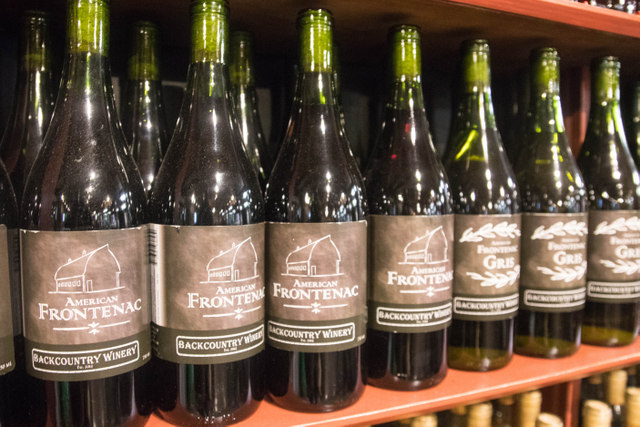
At Backcountry Winery, the Gables grow six varieties of wine grapes. They make 12 different wines, including strawberry, raspberry, cherry and apple wines, and plan to expand to 14 wines soon.
The Gables have invested in an expansion near the barn to accommodate these events. A connecting space on the west side of the barn will include a room when brides can get ready for their wedding. This connecting space is attached to a 60-foot by 90-foot addition that will provide additional production space, storage space and office space for the winery.
This infrastructure is just one part of Backcountry Winery’s recent expansions. While the Gables maintain a vineyard on the east side of the barn, the couple also began leasing an established, 4-acre vineyard near Webster City in the spring of 2017.
“It’s exciting to raise more of our own grapes so we can produce estate wines, which are made from our own crop,” said Amber Gable, who is a member of the Iowa Wine Growers Association. “There’s a great deal of pride in that.”
Wine wins big at Iowa State Fair
This pride is reflected in the large, silver trophy that graces the barn at Backcountry Winery. When the Gables competed in the commercial wine competition at the 2017 Iowa State Fair, the judges selected Vignoles from Backcountry Winery for the top honor, the Governor’s Cup. Vignoles is a semi-dry white wine that boasts crisp flavors of tropical and citrus fruits and a clean finish.
Vignoles is just one of the wines available from Backcountry Winery, where the Gables grow six varieties of wine grapes. They make 12 different wines, including strawberry, raspberry, cherry and apple wines, and plan to expand to 14 wines soon.
Backcountry Winery’s products can be purchased at the winery or through the approximately 25 retailers in Hamilton County and central, northern and northwest Iowa that partner with Backcountry Winery.
Raising specialty crops like wine grapes and offering Iowa wines offer unique opportunities to boost economic development in rural Iowa, Amber Gable said. “When visitors come to our winery, they not only buy wine, but they buy fuel at the convenience store in Stratford, which is owned by the local co-op, and they can go to Stanhope to get a burger. It’s rewarding to promote the whole Hamilton County experience.”
The Gables hope to attract more guests to the area by offering more live music this summer at the winery. This builds on the success of the three performances offered in 2016 and the 10 shows offered in 2017. The 2018 concerts, which range from country to classic rock, cost $5 for admission and will be held on certain Saturdays from 6 p.m. to 8 p.m. in the barn.
“Visiting a winery is all about the experience,” Amber Gable said. “We enjoy creating these memorable experiences, meeting people from across Iowa and beyond and promoting rural Iowa.”
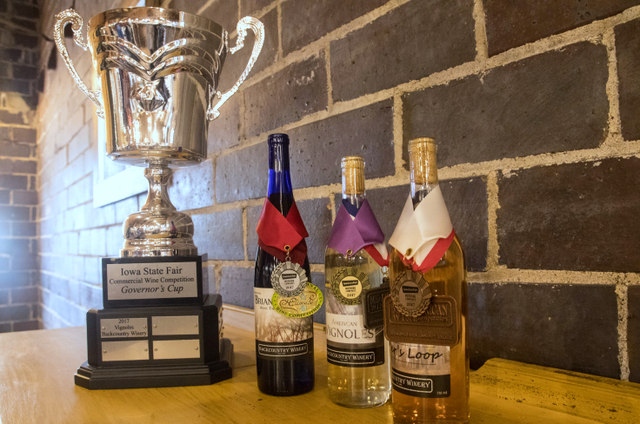
When the Gables competed in the commercial wine competition at the 2017 Iowa State Fair, the judges selected Vignoles from Backcountry Winery for the top honor, the Governor’s Cup. Vignoles is a semi-dry white wine that boasts crisp flavors of tropical and citrus fruits and a clean finish.
Iowa’s Wine Industry, By the Numbers
Data from the Iowa Wine Growers Association (IWGA) shows that Iowa has:
• 103 wineries
• 267 vineyards
• 1,300 acres of grapes
• 8 wine trails
• 40+ cold-climate grapes grown
• $420 million of economic impact in 2012
• 2,600 full-time jobs
• 358,000 wine related tourists per year
On average, the typical Iowa winery produces approximately 3,000 gallons of wine annually. The Iowa native wine industry helps promote and establish additional activity in the state, including lodging, food, travel, gifts, agri-tourism, event centers, festivals, music, art and a host of service industries.
“By our estimation, based on direct feedback from the wineries we surveyed, there was over $2.1 million in revenue generated from these wine-related events and facilities,” according to the 2012 “Economic Impact of Iowa Wine and Wine Grapes” report produced by Frank, Rimerman + Co, LLP.
In order for the industry to keep growing and attracting new visitors, wineries not only need to continue focusing on improving wine quality, but consider expanding into more wine-related events like private parties, weddings and festivals held on winery properties, according to the report.
- I originally wrote this story for the Progress section of Farm News, Ft. Dodge, Iowa in February 2018.
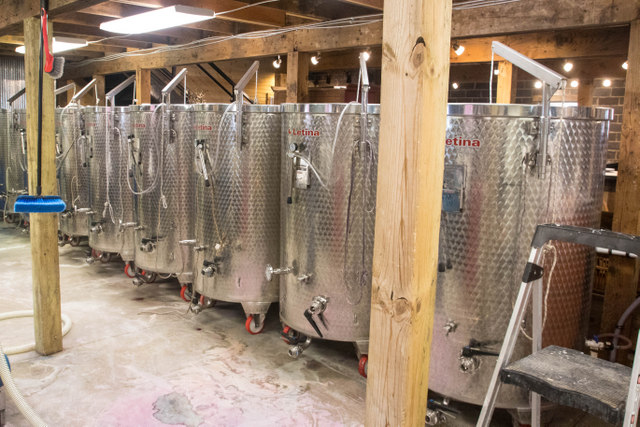
Backcountry Winery’s fermenting equipment is housed in a Hamilton County, Iowa, barn that’s approximately 100 years old.
Want more?
Thanks for stopping by. I invite you to read more of my blog posts if you value intriguing Iowa stories and history, along with Iowa food, agriculture updates, recipes and tips to make you a better communicator.
If you like what you see and want to be notified when I post new stories, be sure to click on the “subscribe to blog updates/newsletter” button at the top of this page, or click here. Feel free to share this with friends and colleagues who might be interested, too.
Also, if you or someone you know could use my writing services (I’m not only Iowa’s storyteller, but a professionally-trained journalist with 20 years of experience), let’s talk. I work with businesses and organizations within Iowa and across the country to unleash the power of great storytelling to define their brand and connect with their audience through clear, compelling blog posts, articles, news releases, feature stories, newsletter articles, social media, video scripts, and photography. Learn more at www.darcymaulsby.com, or e-mail me at yettergirl@yahoo.com.
If you’re hungry for more stories of Iowa history, check out my top-selling “Culinary History of Iowa: Sweet Corn, Pork Tenderloins, Maid-Rites and More” book from The History Press. Also take a look at my latest book, “Dallas County,” and my Calhoun County” book from Arcadia Publishing. Both are filled with vintage photos and compelling stories that showcase he history of small-town and rural Iowa. Order your signed copies today! Iowa postcards are available in my online store, too.
Let’s stay in touch. I’m at darcy@darcymaulsby.com, and yettergirl@yahoo.com.
Talk to you soon!
Darcy
@Copyright 2018 Darcy Maulsby & Co. Blog posts may only be reprinted with permission from Darcy Maulsby.
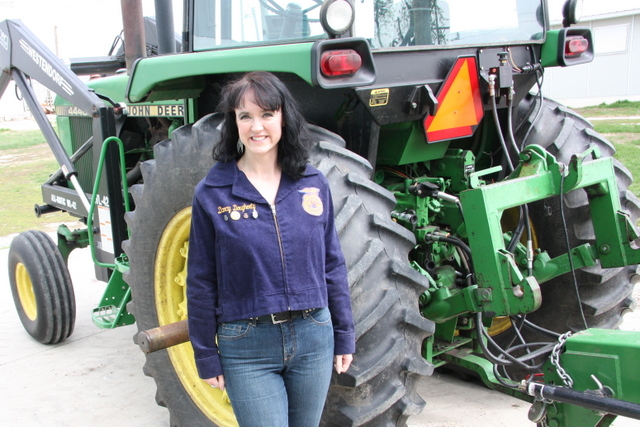
Recalling a Most Unconventional—and Life-Changing–FFA Journey
My FFA story is so unlikely that even I can’t quite believe it myself. It all began in the fall of 1989, when I was starting my sophomore year at Southern Cal High School in Lake City.
As a child of a Farm Crisis, I never thought about joining FFA. I was busy with classes, band, choir, theater and other activities, and the unspoken message was clear—ag has no future, so don’t spend your time there. Then along came Ed Ricks.
Ed was Southern Cal’s ag teacher and FFA advisor. Turns out he was also a talent recruiter. He asked me whether I’d be interested in coming over to the ag building and studying ag rather than taking the standard 10th grade biology class. I was intrigued. Ed worked out an arrangement with the biology teacher so I could skip biology class every day and instead focus on ag, as long as I could pass the biology tests.
No problem.
What a golden opportunity this turned out to be. I discovered a whole new world of learning, plus I didn’t have to be bored in a biology class. (And yes, I always passed the tests.)
I’m forever grateful that Ed welcomed me into the dynamic world of FFA. Not only did I love the ag classes, but it was fun to compete on the horticulture/floriculture team at nationals in Kansas City. My ag adventures truly set me a path that has defined my career for more than 20 years. They also explain why I’m sure a big believer in FFA.
As I look back, it’s amazing to think how much FFA has changed, and what hasn’t changed, since those days.
1. More diversity. When I was in FFA, there were usually only three to five girls at most in our chapter. That era wasn’t that far removed from the days when girls were not allowed to join FFA (a change that didn’t come until 1969.) Now girls often outnumber boys in many FFA chapters. I was excited that our local South Central Calhoun FFA chapter offered a Diversity in Ag class for the first time this fall, thanks to advisor Matt Carlson, to help girls learn more about the diverse career options available in ag today.
2. Ability to inspire. As I worked with the Diversity in Ag students, I remembered just how influential adults can be at this point in an FFA student’s life, and how much we can inspire the next generation of ag leaders, if we only take the time.
3. Learning made fun. While “fun” doesn’t come to mind when I think of most of my high school classes, it’s a word I’ve always associated with ag education. That all stems from my positive experiences in FFA, from working in our greenhouse to competing with teams that traveled from Ames to Des Moines to Kansas City.
4. Competition. Speaking of competition, I grew up in the era before everyone got a participation ribbon, and it made all the difference in my outlook on life. I loved competing on our floriculture/horticulture team. Even when I didn’t do well in certain categories likes salesmanship, I learned how to keep trying, keep learning and keep progressing. I also come from a legacy of FFA competitors. My Uncle Jack Dougherty competed in public speaking at the state FFA convention in Des Moines in 1956, where he focused on soil conservation. My family still quotes his words that “when the soil is gone, so are we.”
5. Real-world connections. These FFA lessons, from soil conservation to sales and communication skills, aren’t just academic theory. They have real-world applications that continue to influence my approach to business, farming and life.
6. Broadening your horizons. Being recruiting into FFA opened up a whole new world of career options I might never have considered. While there isn’t an abundance of children of the 1980s Farm Crisis working in agriculture, I consider myself to be one of the fortunate ones, all because Ed Ricks helped me broaden my horizons.
7. Useful knowledge you don’t learn anywhere else. When I’m at a meeting, I can tell who’s an FFA alum and who’s not, simply by whether a person knows how to conduct a meeting properly with parliamentary procedure. This is such a useful skill, and it’s curious to me that FFA is one of the few organizations that seems to understand its value.
8. Giving back. I remember helping plant and water the flowers in the planters around Lake City’s town square as part of our FFA training. While I just thought this was a fun way to get away from school for awhile, lessons like this helped plant the seed of community service in my life.
9. Leadership. As I volunteer with local FFA chapters today, I’m always inspired by the leadership opportunities that kids embrace at the chapter, district, state and even national levels. A dedicated FFA member always stands out among his or her peers. Some of FFA’s most notable alums have ascended to the highest levels of their chosen professions, from President Jimmy Carter to professional athletes like Bo Jackson to country music superstars Tim McGraw and Taylor Swift.
10. Focus on the future. As I look back, I knew I had a good thing going in high school with FFA, but I wish would have understood even better the amazing opportunities I had. It says a lot about an organization when you realize more of its value the longer you’ve been away from it.
It’s always interesting to me that FFA took root in the mid-1920s to counter the trend of boys losing interest in agriculture and leaving the farm. I think of my own FFA story and am still inspired by the wisdom reflected in the the FFA creed:
“I believe in the future of agriculture, with a faith born not of words but of deeds – achievements won by the present and past generations of agriculturists; in the promise of better days through better ways, even as the better things we now enjoy have come to us from the struggles of former years.”
Long live FFA!
P.S. Thanks for joining me. I’m glad you’re here.
Want more?
Thanks for stopping by. I invite you to read more of my blog posts if you value intriguing Iowa stories and history, along with Iowa food, agriculture updates, recipes and tips to make you a better communicator.
If you like what you see and want to be notified when I post new stories, be sure to click on the “subscribe to blog updates/newsletter” button at the top of this page, or click here. Feel free to share this with friends and colleagues who might be interested, too.
Also, if you or someone you know could use my writing services (I’m not only Iowa’s storyteller, but a professionally-trained journalist with 20 years of experience), let’s talk. I work with businesses and organizations within Iowa and across the country to unleash the power of great storytelling to define their brand and connect with their audience through clear, compelling blog posts, articles, news releases, feature stories, newsletter articles, social media, video scripts, and photography. Learn more at www.darcymaulsby.com, or e-mail me at yettergirl@yahoo.com.
If you’re hungry for more stories of Iowa history, check out my top-selling “Culinary History of Iowa: Sweet Corn, Pork Tenderloins, Maid-Rites and More” book from The History Press. Also take a look at my latest book, “Dallas County,” and my Calhoun County” book from Arcadia Publishing. Both are filled with vintage photos and compelling stories that showcase he history of small-town and rural Iowa. Order your signed copies today! Iowa postcards are available in my online store, too.
Let’s stay in touch. I’m at darcy@darcymaulsby.com, and yettergirl@yahoo.com.
Talk to you soon!
Darcy
@Copyright 2018 Darcy Maulsby & Co. Blog posts may only be reprinted with permission from Darcy Maulsby.
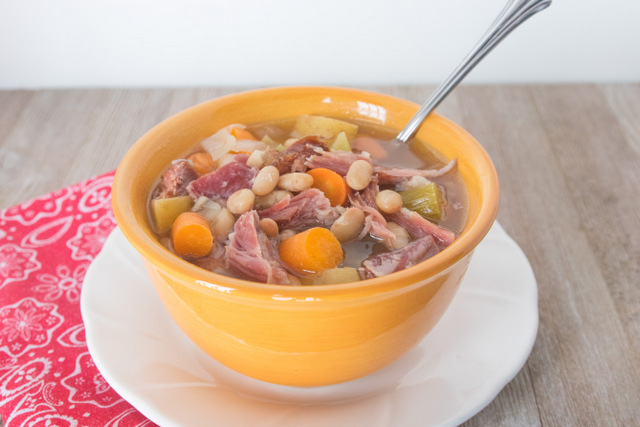
In Praise of Ham and Bean Soup
I’ve never understood why a smoky, delicious ham and bean soup is so hard to find. Heck, just a lackluster, ho-hum ham and bean soup is often hard to find.
I always figured no one knows more about ham and bean soup than Iowa farm cooks, especially when those who grew up on a hog farm like I did. Pork galore in all its forms was a staple on our family’s dinner table for generations. Plus, soup night was always Sunday night at our farm—and it still is. What a treat when ham and bean soup is on the menu!
With its rich broth and smoky undertones, there’s nothing like a hearty ham and bean soup to chase away the winter chill (or bitter cold, depending on what Mother Nature throws at us.) As I’ve refined my own recipe through the years, I’ve come to three conclusions:
1. You MUST have a thick, smoked ham hock (also known as a ham shank) to make the magic. No cubes of cured ham are going to cut it, if you want maximum flavor. This is a heavy-duty, low-and-slow kind of job for a tough, smoky ham shank.
2. We’re blessed to have many great meat lockers in Iowa, a reflection of our thriving livestock industry, where I can get fabulous smoked ham hocks. One of my favorite suppliers? Lewright Meats in Eagle Grove, which has been serving northern Iowa since 1936.
3. Adding diced potatoes is a good thing for ham and bean soup. I like to add oomph to my cooking, and how can you go wrong with extra veggies? Adding potatoes might be a bit non-traditional for ham and bean soup, but that’s how I roll.
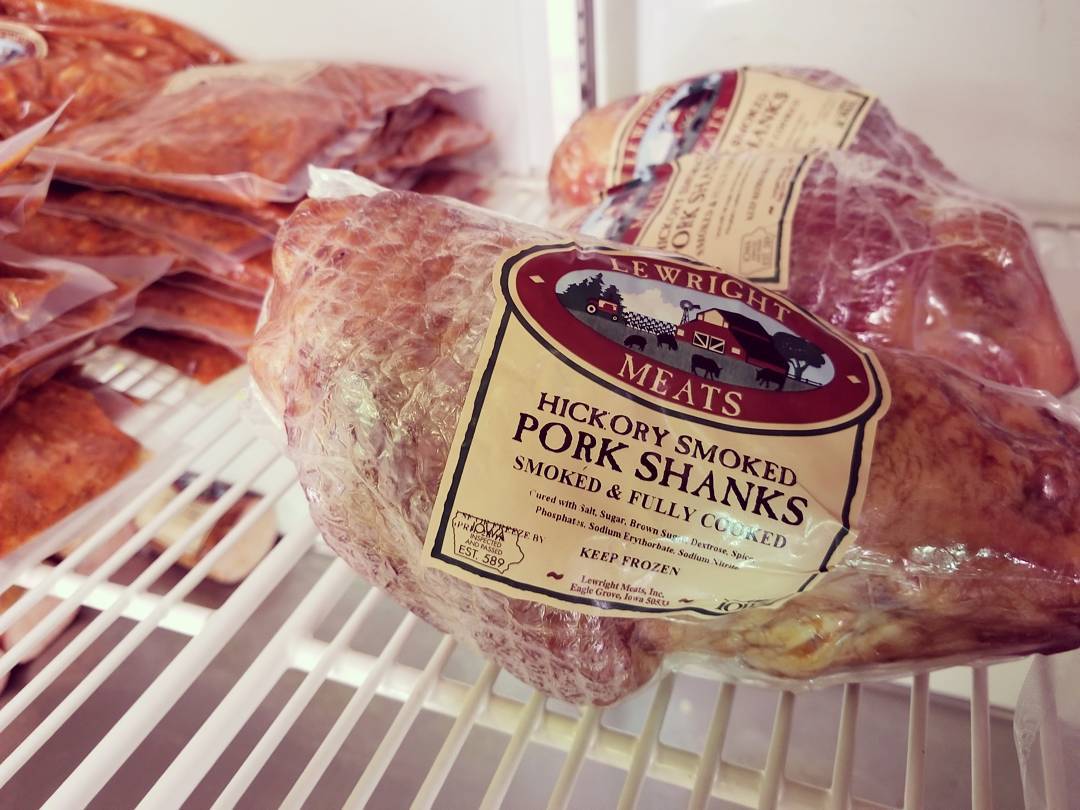
This smoked ham hock from Lewright Meats in Eagle Grove is the key to a great ham and bean soup.
The thing about ham and bean soup is that it can be a palette you fine-tune to your own tastes. Don’t like garlic? Leave it out. Want more onions in the mix? Add another one. (As my dear neighbor and farm cook extraordinaire Alice Ann Dial taught me, onions are a cheap way to add lots of flavor.)
The story behind Congress and Bean Soup
“Thunderation,” roared Speaker of the House Joe Cannon of Illinois. “I had my mouth set for bean soup! From now on, hot or cold, rain, snow, or shine, I want it on the menu every day.”
Obviously, ham and bean soup isn’t just a farm favorite. Turns out it has a rich history in the kitchens of Washington, D.C., too.
While ham and bean soup was a common item on the U.S. House of Representatives’ menu before the turn of the 20th century, it became a permanent fixture in the institution when Speaker Joe Cannon of Illinois discovered that his favorite meal had not been prepared by the kitchen staff on a hot, summer day in 1904.
Cannon, who was the namesake of the Cannon House Office Building, served in the U.S. House for 46 years. Dismayed by that egregious menu omission in 1904, the Speaker directed that bean soup be served in the House every day, regardless of the weather.
More than a century after Speaker Cannon’s decree, bean soup remains on the menu in the House Restaurant, making it one of the more longstanding and famous traditions in the House.
Members of the U.S. House aren’t the only fans of ham and bean soup. It’s also on the menu in the Senate’s restaurant every day. There are several stories about the origin of that mandate, but none has been corroborated.
According to one story, the Senate’s bean soup tradition began early in the 20th-century at the request of Senator Fred Dubois of Idaho. Another story attributes the request to Senator Knute Nelson of Minnesota, who expressed his fondness for the soup in 1903.
The recipe attributed to Dubois includes mashed potatoes and makes a 5-gallon batch. The recipe served in the Senate today does not include mashed potatoes, but does include a braised onion. Click here to check out both Senate recipes.
No matter how you like your ham and bean soup, here’s my take on this American classic. Enjoy, and let me know what you think.
Darcy’s Hearty Ham and Bean Soup
1 smoked ham hock (also called a smoked ham shank)—the meatier, the better
1 48-ounce jar great northern beans (I don’t drain and rinse the beans—I add it all)
3 stalks celery, diced
3 carrots, peeled and sliced
3 to 4 medium potatoes, diced (I prefer Yukon Golds)
1 large onion, chopped
1 tablespoon garlic, minced
1 teaspoon fresh-ground pepper
Water or chicken stock
Salt, to taste
Place ham hock in slow cooker. Add beans, celery, carrots, potatoes, onion, garlic and pepper. Cover with water or chicken stock until slow cooker is full. (If using water rather than chicken stock, I often add 2 or 3 teaspoons of Better Than Bouillon chicken soup base to add more flavor.)
Cook on low for 8 to 10 hours. (I often prepare the soup in the evening and let it cook overnight.) Remove ham hock, allow it to cool, and remove ham from the bone. Add ham back to the soup. Taste the soup to see if it needs salt. Add salt, if desired. (Some ham hocks add enough flavor to the broth that no salt is needed.)
• Note: homemade soup often develops more flavor if you let it sit in the refrigerator overnight and serve the soup the next day. This Hearty Ham and Bean Soup is so good, though, that I understand if you dig in right away!
P.S. Thanks for joining me. I’m glad you’re here.
Want more?
Thanks for stopping by. I invite you to read more of my blog posts if you value intriguing Iowa stories and history, along with Iowa food, agriculture updates, recipes and tips to make you a better communicator.
If you like what you see and want to be notified when I post new stories, be sure to click on the “subscribe to blog updates/newsletter” button at the top of this page, or click here. Feel free to share this with friends and colleagues who might be interested, too.
Also, if you or someone you know could use my writing services (I’m not only Iowa’s storyteller, but a professionally-trained journalist with 20 years of experience), let’s talk. I work with businesses and organizations within Iowa and across the country to unleash the power of great storytelling to define their brand and connect with their audience through clear, compelling blog posts, articles, news releases, feature stories, newsletter articles, social media, video scripts, and photography. Learn more at www.darcymaulsby.com, or e-mail me at yettergirl@yahoo.com.
If you’re hungry for more stories of Iowa history, check out my top-selling “Culinary History of Iowa: Sweet Corn, Pork Tenderloins, Maid-Rites and More” book from The History Press. Also take a look at my latest book, “Dallas County,” and my Calhoun County” book from Arcadia Publishing. Both are filled with vintage photos and compelling stories that showcase he history of small-town and rural Iowa. Order your signed copies today! Iowa postcards are available in my online store, too.
Let’s stay in touch. I’m at darcy@darcymaulsby.com, and yettergirl@yahoo.com.
Talk to you soon!
Darcy
@Copyright 2018 Darcy Maulsby & Co.
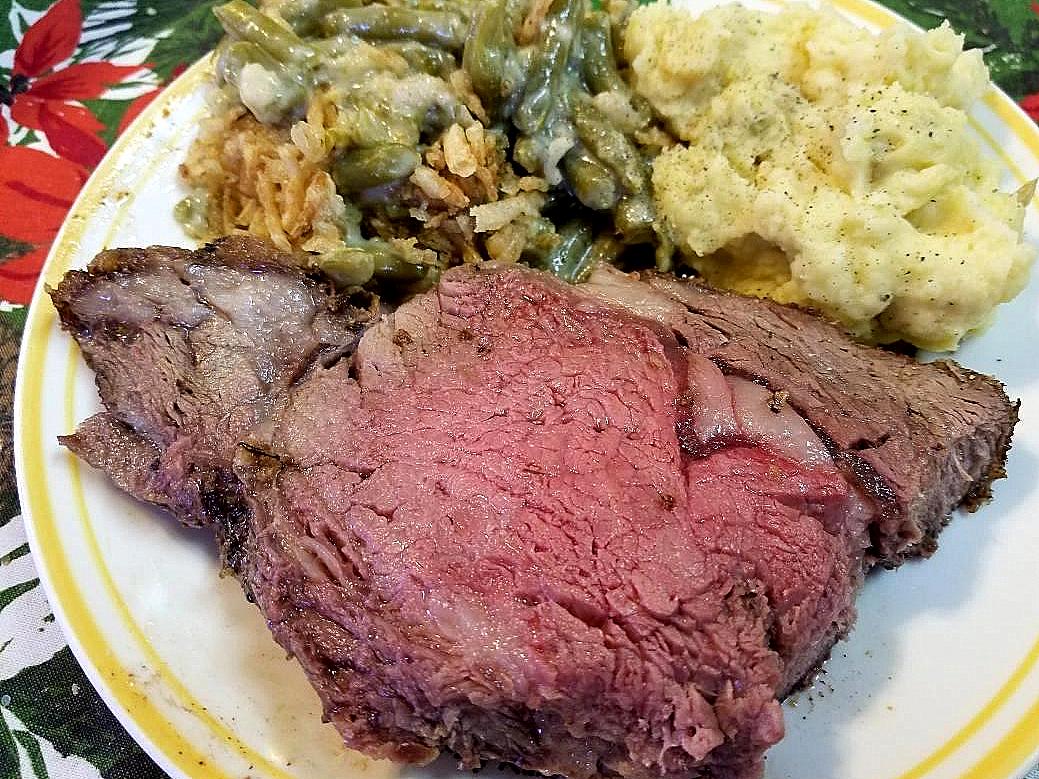
How to Cook a Perfect Prime Rib
Would you believe me if I told you restaurant-quality prime rib is one of the easiest main courses to prepare, plus you’ll look like a gourmet chef in the process? Yep, it’s true.
Take it from this Iowa farm girl. I adore the taste of prime rib. So tender, so robust, and bursting with all the flavor and juiciness that makes each bite a little trip to paradise.
When my family asked me to cook prime rib for New Year’s Day dinner, I didn’t hesitate. The prep couldn’t be simpler, and the results are simply spectacular. When you serve this delectable prime rib, your guests (possibly even the vegetarians) will be begging for more.
Let’s get cookin.’
Darcy’s Prime Rib
Select the right size roast. Allow at least 6 ounces of cooked, trimmed meat per adult. I cooked an 8-pound roast for our gathering, because I like to have leftovers. Beef and veggie soup, anyone?
Preheat the oven. Crank it up to 450 degrees Fahrenheit, and let it heat up for about 30 minutes. Also, you can remove the beef roast from the refrigerator at this time.
Gather your supplies. I recommend a metal roasting pan with a rack (like the one you might use to cook at turkey), olive oil, kosher salt, and fresh-ground pepper. Oh, and don’t forget to round up some soap and wash your hands thoroughly. We’re in the kitchen prepping food, after all!

Rachet-style pepper mill in red!
• A side note about fresh-ground pepper. I LOVE my Kuhn Rikon® high-output ratchet mill. (Check out a video here to see it in action). I appreciate the easy and speed of these wonder gadgets, plus I adore the red color of my pepper mill, since it matches my kitchen. One more thing—don’t think you’re limited to filling it with black peppercorns only. After interviewing a chef years ago about how to amp up the flavor in any dish, I took his advice and use of mix of peppercorns, including black, green, red and white, which bring a different flavor to the party.
Season the beef. Follow the K.I.S.S. method (keep it simple stupid). Prime rib roast doesn’t need a marinade or any complicated preparations, since the meat speaks for itself. Drizzle olive oil on the roast. Spread it around the roast with your hands. Next, liberally rub kosher salt and plenty of fresh-ground pepper on the meat. I don’t measure—I just go with what looks right.
If you’re thinking about using an herb mix to season the meat, I say go right ahead. I like to use this homemade herb blend that I learned to make at my dear friend Shannon Latham’s Enchanted Acres pumpkin patch near Sheffield, Iowa. I’m a big fan of the recipe here for Save Summer in a Jar Herb-Salt Mix and used it on my New Year’s prime rib–divine! Thanks to my friend Mary Lovstad of Farm Girl Cook’n in northern Iowa for all the inspiration!
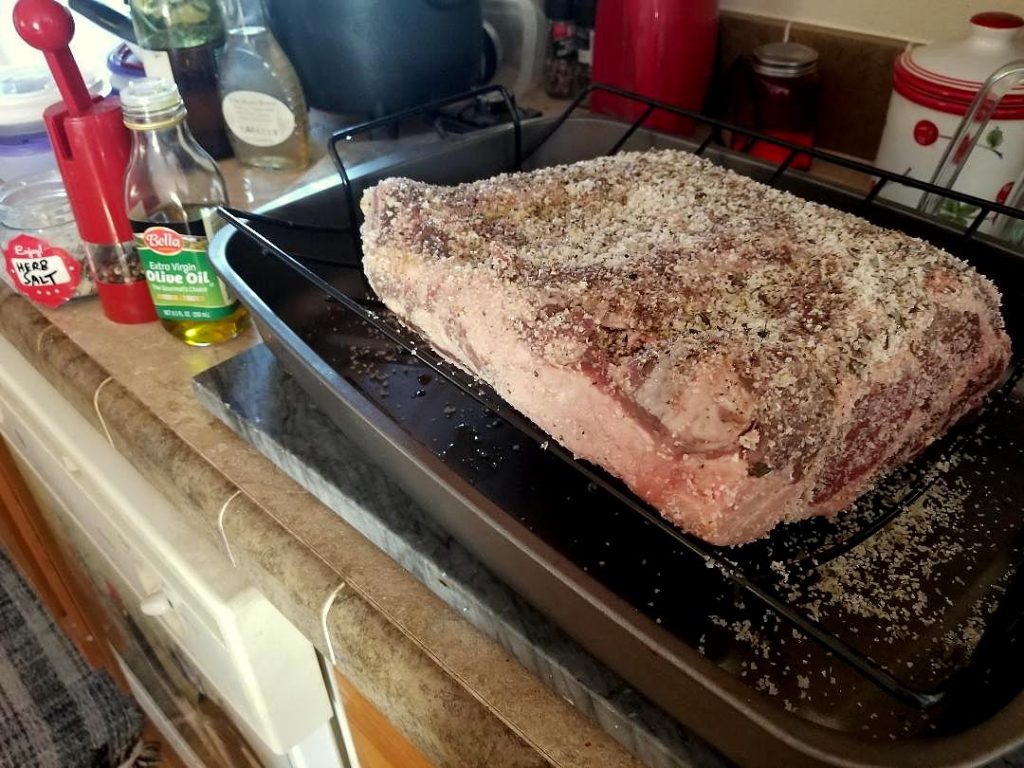
Dry rubs enhance any beef roast
Bake. Place the meat in a roasting pan that’s slightly bigger than the roast itself. I like a roasting pan and roasting rack, myself. Note–one side of the meat will have more fat on it. You want the fatty side facing up so the meat will baste itself as it cooks.
Finally, don’t add water to the pan, and don’t cover the roast. Just pop it in in the oven.
Timing is everything. How long does it take to cook a prime rib? Well, it depends. I like to start with a high temperature (450 degrees) for the first 30 minutes. Then I drop the heat to 325 degrees and allow about 13 to 15 minutes of cooking time per pound of beef.
DO NOT keep opening the oven door to check the meat. Just enjoy the tempting sizzle as the pan drippings appear during the first phase of cooking. Then savor the aromas as the beef finishes cooking over the next few hours.
A thermometer is the best way to guarantee the roast turns out exactly the way you want it. For an accurate reading, push the thermometer into the middle of the roast, making sure the tip is not touching fat or bone (or the pan). FYI–medium rare is about 130 degrees F. If that’s what you’re going for (confession–it’s my personal favorite), take the meat out of the oven when it’s around 120 degrees F. Remember that the roast’s temperature will rise at least 5 degrees after you remove it from the oven.
Let it rest. Warning—the prime rib will look incredible when you pull it out of the oven, but resist the urge to carve it right away. Let this meaty masterpiece rest for 15 or 20 minutes before carving to let the juices return to the center. Cover the roast with a “tent” of tinfoil. (If you’re at my house, be warned. My dog, Maggie the Red Heeler, is obsessed with tinfoil and will bark like a maniac when I tear a sheet of foil from the roll. Silly dog.)
With prime rib, it’s easy to satisfy everyone’s preference for doneness. The slices taken from the ends of the roast will be the most done, and the middle will be the least done.
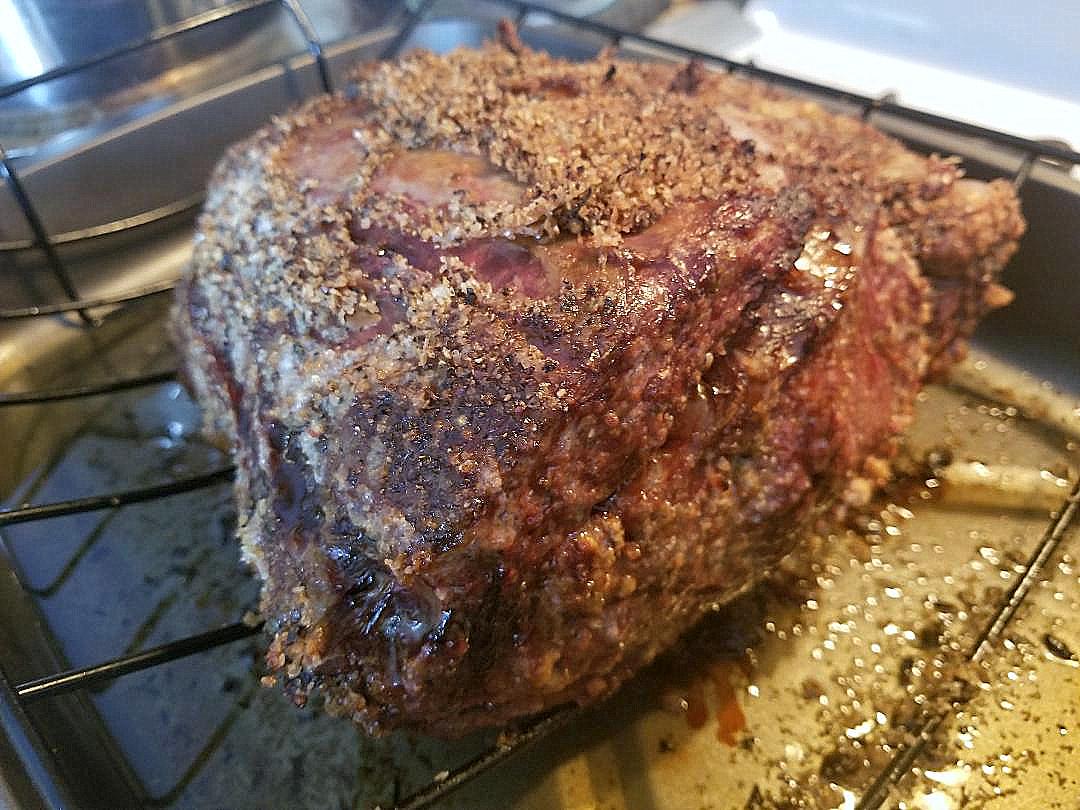
Prime rib right out of my oven
Add a little something extra. When the roast is done make sure you use the drippings in the bottom of the pan to make gravy. Then you’ll have a head-start on the most flavor-packed beef stew you can imagine.
Next time I prepare a prime rib, I’m going to try Food Network Chef Bobby Flay’s idea for Prime Rib with Thyme au Jus. Here’s what he recommends:
Place the roasting pan on top of the stove over 2 burners set on high heat. Add the wine to the pan drippings in the pan and cook over high heat until reduced, scraping the bottom of the pan with a wooden spoon. Add the stock and cook until reduced by half. Whisk in the thyme and season with salt and pepper, to taste.
Tell me all about it. Bottom line? Do not fear cooking prime rib, even though this is a pricey cut. You can do this! When you do, be sure to leave a comment, e-mail me, post on social media and tell me all about it.
Did you know?
“Prime rib” is not a specific cut of beef but is actually a preparation method for a beef rib roast. If you know the standard meat roasting method, you can make prime rib out of several types of beef rib roasts, according to my friends at the Iowa Beef Industry Council.
Check out their handy Beef Roast Basics guide. You’ll find tips on how to know what size beef roast to purchase, how to carve meat like a pro and more.

How’s this for a plate of prime rib perfection?
More reasons why beef is good
With my background as an ag journalist, I love to highlight agriculture, especially Iowa agriculture. Why do we know beef here in the Heartland? Because Iowa is in the top 10 beef-producing states in America, terms of all cattle and calves (ranking #7).
Here’s a snapshot of Iowa’s beef industry, which is a powerhouse in terms of economic development and providing a safe, nutritious product that nourishes people around the world:
- Total cattle inventory in Iowa (as of January 1, 2017): 3,850,000
- Number of feedlots (2012 Census): 6,036
- Number of cattle operations (2012 Census): 26,827
- Number of farms with beef cows (2012 Census): 19,677
- Iowa jobs directly related to the cattle industry (2015): 20,690
- Iowa jobs indirectly related to the cattle industry (2015): 7,384
- In 2015, Iowa’s cattle industry contributed more than $6.9 billion in business activity to Iowa’s economy.* Sources: Department of Economics, Iowa State University; Iowa Agricultural Statistics, U.S. Department of Agriculture; 2017 Cattle Inventory Report National Agricultural Statistics Service (NASS), Agricultural Statistics Board, United States Department of Agriculture (USDA).
Can’t get enough beef?
There’s no such thing as too much beef if you love it as much as I do. I think my friend Larry Irwin would agree, especially when it comes to hamburgers.
Make no mistake, the humble hamburger still reigns supreme from backyard barbecues to fast-food drive-ins across Iowa. But this Iowa icon also provides the perfect palette for culinary creativity when Larry Irwin showcases his Burger of the Month flavors in my hometown of Lake City. Get the story and the recipes here.
Also, get your grill on and build a better burger with my top tips.
Finally, I just had to share this photo below. My relatives in Webster County, the Walrod family, did extremely well on the show circuit this year with their beef cattle and took top honors with their Limousin cattle at the Iowa State Fair. Why not decorate the Christmas tree to celebrate a banner year?
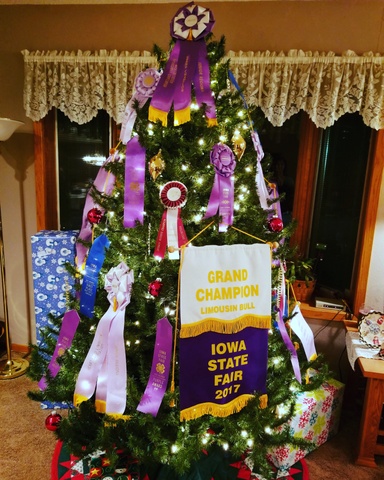
Cattle banners on the Christmas tree in Iowa
Want more?
Thanks for stopping by. I invite you to read more of my blog posts if you value intriguing Iowa stories and history, along with Iowa food, agriculture updates, recipes and tips to make you a better communicator.
If you like what you see and want to be notified when I post new stories, be sure to click on the “subscribe to blog updates/newsletter” button at the top of this page, or click here. Feel free to share this with friends and colleagues who might be interested, too.
If you’re hungry for more stories of Iowa history, check out my top-selling “Culinary History of Iowa: Sweet Corn, Pork Tenderloins, Maid-Rites and More” book from The History Press. Also take a look at my latest book, “Dallas County,” and my Calhoun County” book from Arcadia Publishing. Both are filled with vintage photos and compelling stories that showcase he history of small-town and rural Iowa. Order your signed copies today! Iowa postcards are available in my online store, too.
Also, if you or someone you know could use my writing services (I’m not only Iowa’s storyteller, but a professionally-trained journalist with 20 years of experience), let’s talk. I work with businesses and organizations within Iowa and across the country to unleash the power of great storytelling to define their brand and connect with their audience through clear, compelling blog posts, articles, news releases, feature stories, newsletter articles, social media, video scripts, and photography. Learn more at www.darcymaulsby.com, or e-mail me at yettergirl@yahoo.com.
Let’s stay in touch. I’m at darcy@darcymaulsby.com, and yettergirl@yahoo.com.
Talk to you soon!
Darcy
P.S. Thanks for joining me. I’m glad you’re here.
@Copyright 2018 Darcy Maulsby & Co.

Always Alert-How to Stay Safe in Any Situation
What was that? None of us knew what was going on at first, and I was confused—and alarmed.
It happened on the bright, sunny morning of October 16, as hundreds of us were gathered at 9 a.m. in the ballroom of the downtown Marriott Hotel in Des Moines for the Iowa Hunger Summit. I thought this would just be another routine meeting to cover. Boy, was I wrong.
After opening remarks from Ambassador Kenneth Quinn, president of the World Food Prize Foundation, and Iowa Farm Bureau Federation President Craig Hill, five former U.S. Department of Agriculture secretaries (including Tom Vilsack, Ed Schafer, Mike Johanns, Ann Veneman, and Dan Glickman) stepped on stage for a panel discussion. (You can read my recap of the panel discussion in my article “Hungry for Answers” in Farm News.)
Suddenly there was a ruckus from the back of the ballroom. There were voices shouting, although I couldn’t make out the words at first. Everyone began looking around to see what was going on. Was this a surprise part of the program?
Suddenly a small group of young men holding a large white banner painted with red lettering marched down the aisle. It soon became evident they were chanting about “hell no GMOs” over and over. A slender young woman dashed after them, capturing the footage on her cell phone.
It also became clear this group intended to stand between the bewildered audience and row of former ag secretaries on stage, as the protestors belted out their angry chant. I don’t know exactly how long the group took over the Iowa Hunger Summit, but it seemed much longer than it probably was.
It appeared that most of the audience, myself included, froze in shock, desperately hoping someone would take control of the situation.
Finally, a tall gentleman dressed in a business suit demanded that the protestors leave, herding them at times towards the side exit doors, since the group showed no signs of leaving voluntarily. One protestor nearly knocked over Iowa Public Television’s camera near the side of the stage as he and his cohorts continued shouting.
The spectacle didn’t come to an end until the protestors turned to face the audience as they were escorted out of the side doors, bellowing, “Shame, shame, shame” all the way.
While I breathed a big sigh of relief as the Iowa Hunger Summit proceeded without incident, I couldn’t help but think about the mass shooting in Las Vegas just days before. I also started thinking how vulnerable all of us were in that ballroom, if the worst had happened.
What if the worst had happened?
I started researching personal safety and situational awareness and am now rethinking the way I view the world. In many ways, these safety tips boil down to the power of observation, a tool I use daily as a writer and encourage you to use, as well.
• Think ahead. A 2014 study from the Federal Bureau of Investigation (FBI) found that most active shooter events end in 2 minutes or less. This means you have little time to think if you’re caught in this situation. You’ve got to have a plan ahead of time, since you may only have seconds to act.
• Know your natural tendencies. When any sort of emergency arises, be it an active shooter or even a fire, the natural response for most people, surprisingly enough, is to not do anything. It’s human nature to freeze up in emergency situations. Another bias that keeps us from taking action is our natural tendency to follow the crowd. If we see that everyone else is locked up by inertia, we tend to act the same. Be aware of these forces, and prepare to counteract them.
• Visualize for safety. When you enter a public space, whether it’s a hotel meeting room, restaurant, airport, theater or other venue, take note of the exits. Also, put yourself in position so you can observe as much of your surroundings as possible. Try to sit with your back against the wall, for example, not the larger room where someone can come up behind you.
• Stay in “condition yellow.” This means you’re relaxed but always alert. Remaining aware of your surroundings will give you a head start if an emergency arises. Some safety experts call this ABO (Always Be Orienting). Don’t get so absorbed in your smartphone, for example, that you fail to pay attention to the world around you.
• Establish baselines and look for anomalies. Know what’s normal in a given situation. If something seems out of the ordinary, keep an eye on it.
• Play the “A” game. The “A” game, or awareness game, means you take note of details everywhere you go, from the gender, hair color and clothing of the person behind the counter at the convenience store to the number of exits you see in the theater. This game trains you to be mindful of your surroundings and can help you create a plan of action wherever you go.
• Call 911. If you find yourself in the midst of an emergency, get to safety as soon as possible, and then call 911. Don’t assume someone else already has.
It takes practice to truly pay attention to what’s going on around you, but this skill can a long ways in keeping you from appearing like an easy target. You want to get to the point where situational awareness is just part of your daily routine, much like looking both ways before you cross the street.
Don’t be paranoid, just mindful. Honing your powers of observation will pay big dividends and might even save your life.
Want more?
Thanks for stopping by. I invite you to read more of my blog posts if you want more intriguing Iowa stories and history, along with Iowa food, recipes and tips to make you a better communicator.
If you like what you see and want to be notified when I post new stories, be sure to click on the “subscribe to blog updates/newsletter” button at the top of this page. Feel free to share this information with friends and colleagues who might be interested, too. Talk to you soon!
P.S. Thanks for joining me. I’m glad you’re here.
@Copyright 2017 Darcy Maulsby & Co.
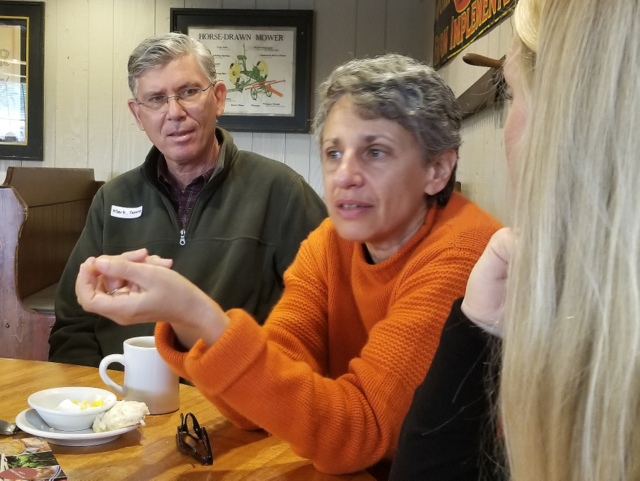
6 Steps for More Effective and Less Confrontational Conversations!
When was the last time you changed your mind? Not about something fairly inconsequential, like what to eat for supper tonight, but about a pivotal issue where you took a stand but later changed your mind?
Probably not lately. Maybe never.
It was an intriguing question posed by fellow writer Tamar Haspel–a question that still has me pondering its ramifications a few weeks after Haspel’s visit to Iowa.
“Many people go into conversations about food and agriculture with the expectations of changing others’ minds,” said Tamar Haspel, a Washington Post columnist who accepted the Iowa Food and Family Project’s invitation to tour Iowa farms in late September and learn more about Midwest agriculture. “We need to stop talking past each other.”

Tamar Haspel provided plenty of food for thought during her lecture about Iowa food and farming–and how to have more productive conversations about these topics–during a late September presentation at Drake University in Des Moines.
Yes, we need to stop talking past each other, I thought after Haspel uttered these sentiments during a breakfast meeting at the Iowa Machine Shed. It appeared that a lot of of the other ag leaders around the table with me were thinking the same thing.
If we believe we need to stop talking past each other, we need to understand more about how humans make decisions. Scottish philosopher and historian David Hume figured it out more than 200 years ago, Haspel noted, when he stated that reason is merely the “slave to the passions.”
“Why are we so bad at evaluating evidence?” asked Haspel, who is a Cape Cod oyster farmer and award-winning journalist who covers food supply issues, including biotech, pesticides, antibiotics, organics, nutrition and food policy.
Blame the confirmation bias, the human tendency to search for, interpret, favor and recall information that confirms one’s preexisting beliefs.
“Think about where the presets are on your car or truck radio,” said Haspel, who spoke at Drake University to approximately 50 people, including myself, on Sept. 27 during a public forum hosted by the Iowa Food and Family Project. “Think of the news sources you turn to and the people you follow on social media. All of us tend to live in our silo surrounded by people who think like us.”
How does all this play out with food and agriculture? Consider the facts. Farmers are mostly rural (no surprise) and Republican, based on campaign contributions reported to the Federal Election Commission. Activists and journalist are almost the exact opposite in these areas, Haspel said.
“This means farmers, activists and journalists are coming at food and agriculture issues with two completely different sets of values,” Haspel added.
6 steps for more effective conversations
This also means facts alone often aren’t persuasive. “So how do we communicate about food and farming? There are no good answers,” Haspel acknowledged.
Still, she offered six key steps to foster better communication, especially regarding food and agriculture topics:
1. Be persuaded that dynamics like the confirmation bias are real. While people often feel like they are rational human beings, everyone is susceptible to less-than-rational thinking. It’s time to re-evaluate the nature of certainty. “Are you right about everything?” Haspel asked the audience, who chuckled at the question. “So what aren’t you right about? It’s very difficult for us to spot where we go wrong, yet it’s easy to spot where others go wrong.” Two key questions keep Haspel awake at night as she strives to address her confirmation biases. “What do I get wrong? What am I not seeing? When you ask these questions, you go out into the world a little more circumspect,” she said.
2. Reconsider bias. Not only does everyone have biases, but bias is a necessary part of the human condition, Haspel said. “Expecting people to be objective is unfair.”
3. Drop “anti-science” from your vocabulary. “There’s science to say anything,” Haspel said. “When this plays out in the GMO debate, saying, ‘You’re anti-science’ translates as ‘you’re an idiot and I’m not.’”
4. Vet your sources. Assess the credibility of news sources, and seek various points of view. “I try to make sure my Twitter feed has lots of people I don’t agree with, along with people I agree with,” Haspel said.
5. Acknowledge truth on both sides. During her tour of Iowa farms, Haspel observed how many farmers feel beleaguered and lead with their defense. She also understands where this mindset comes from, as some audience members at Drake quizzed her about whether large-scale farming changes farmers’ motivations and turns agriculture into a profit-driven operation only. Other audience members questioned farmers’ commitment to protecting water quality and stressed the need for more regulation. “I talked with Iowa farmers who are definitely stewards of the land,” Haspel said. “But are there farmers who aren’t doing it right? Yes, there’s a minority for whom these criticisms apply. Since there is justice in some of the criticism, maybe that can help us find some common ground.”
6. Find intelligent people who disagree with you, and listen. “It’s so easy for us to talk to people who agree with us,” Haspel said. “I try to find the smartest person I know who doesn’t agree with me, and I listen carefully.”
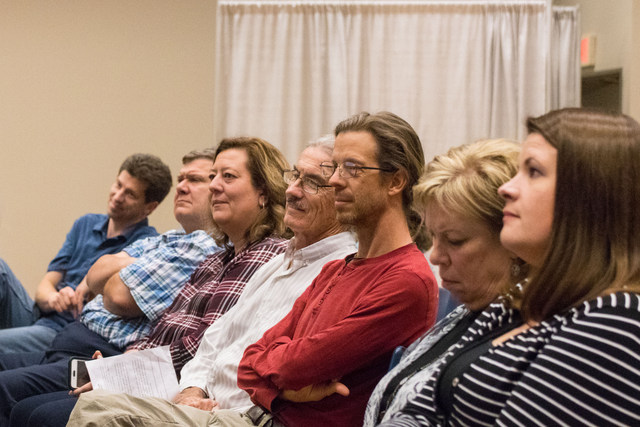
Audience members at Drake University in Des Moines, including Iowa Turkey Federation Executive Director Gretta Irwin (third from left) pondered Tamar Hapels’ 6 tips on more effective conversations involving food and ag topics.
Opening minds, acknowledging truth
I was fascinated by what I was hearing. I also wanted to talk this through with a colleague who attended Haspel’s lecture. I reached out to Gretta Irwin, a home economist and executive director of the Iowa Turkey Federation.
“Tamar opened our minds by helping us understand how we form opinions,” Irwin told me. “She also provided great examples of how we need to be open to thinking about questions, acknowledging truths on both sides, admitting where improvements can be made and learning more about the perspective of the opposing view.”
When questioned about modern agriculture, Haspel did a great job presenting both perspectives of the issue, Irwin added. “She clearly showed there’s no simple solution to issues facing agriculture.”
I also checked in with Sean McMahon, executive director of the Iowa Agriculture Water Alliance.
“Tamar’s comments that we can all be more introspective and work to better understand the other side’s perspectives resonated with me. Welcoming constructive dialogue, in the spirit of continuous improvement, can help further efforts.”
He also liked Haspel’s emphasis on storytelling, as did I. “Tamar’s advice that we should seek to influence through storytelling rather than through facts, figures, and science also struck a chord with me. By putting a human face on efforts and progress, we can reach more people with our story.”
Haspel encourages people to visit farms, have face-to-face conversations with farmers, try to see the benefits of all kinds of agriculture and find common ground, when possible. “If we can do nothing else, we can be kind,” Haspel said. “The common commitment to feeding people can also get us past the rhetoric.”
Want more?
Thanks for stopping by. I invite you to read more of my blog posts if you want more more intriguing Iowa stories and history, along with Iowa food, recipes and tips to make you a better communicator.
If you like what you see and want to be notified when I post new stories, be sure to click on the “subscribe to blog updates/newsletter” button at the top of this page. Feel free to share this information with friends and colleagues who might be interested, too.
If you’re hungry for more stories of Iowa history, check out my top-selling “Culinary History of Iowa: Sweet Corn, Pork Tenderloins, Maid-Rites and More” book from The History Press. Also take a look at my latest book, “Dallas County,” and my Calhoun County” book from Arcadia Publishing. Both are filled with vintage photos and compelling stories that showcase he history of small-town and rural Iowa. Order your signed copies today! Iowa postcards are available in my online store, too.
Let’s stay in touch. I’m at darcy@darcymaulsby.com, and yettergirl@yahoo.com.
Thanks,
Darcy
P.S. Thanks for joining me. I’m glad you’re here.
@Copyright 2017 Darcy Maulsby & Co.

6 Steps for More Effective and Less Confrontational Conversations
When was the last time you changed your mind? Not about something fairly inconsequential, like what to eat for supper tonight, but about a pivotal issue where you took a stand but later changed your mind?
Probably not lately. Maybe never.
It was an intriguing question posed by fellow writer Tamar Haspel–a question that still has me pondering its ramifications a few weeks after Haspel’s visit to Iowa.
“Many people go into conversations about food and agriculture with the expectations of changing others’ minds,” said Tamar Haspel, a Washington Post columnist who accepted the Iowa Food and Family Project’s invitation to tour Iowa farms in late September and learn more about Midwest agriculture. “We need to stop talking past each other.”

Tamar Haspel provided plenty of food for thought during her lecture about Iowa food and farming–and how to have more productive conversations about these topics–during a late September presentation at Drake University in Des Moines.
Yes, we need to stop talking past each other, I thought after Haspel uttered these sentiments during a breakfast meeting at the Iowa Machine Shed. It appeared that a lot of of the other ag leaders around the table with me were thinking the same thing.
If we believe we need to stop talking past each other, we need to understand more about how humans make decisions. Scottish philosopher and historian David Hume figured it out more than 200 years ago, Haspel noted, when he stated that reason is merely the “slave to the passions.”
“Why are we so bad at evaluating evidence?” asked Haspel, who is a Cape Cod oyster farmer and award-winning journalist who covers food supply issues, including biotech, pesticides, antibiotics, organics, nutrition and food policy.
Blame the confirmation bias, the human tendency to search for, interpret, favor and recall information that confirms one’s preexisting beliefs.
“Think about where the presets are on your car or truck radio,” said Haspel, who spoke at Drake University to approximately 50 people, including myself, on Sept. 27 during a public forum hosted by the Iowa Food and Family Project. “Think of the news sources you turn to and the people you follow on social media. All of us tend to live in our silo surrounded by people who think like us.”
How does all this play out with food and agriculture? Consider the facts. Farmers are mostly rural (no surprise) and Republican, based on campaign contributions reported to the Federal Election Commission. Activists and journalist are almost the exact opposite in these areas, Haspel said.
“This means farmers, activists and journalists are coming at food and agriculture issues with two completely different sets of values,” Haspel added.
6 steps for more effective conversations
This also means facts alone often aren’t persuasive. “So how do we communicate about food and farming? There are no good answers,” Haspel acknowledged.
Still, she offered six key steps to foster better communication, especially regarding food and agriculture topics:
1. Be persuaded that dynamics like the confirmation bias are real. While people often feel like they are rational human beings, everyone is susceptible to less-than-rational thinking. It’s time to re-evaluate the nature of certainty. “Are you right about everything?” Haspel asked the audience, who chuckled at the question. “So what aren’t you right about? It’s very difficult for us to spot where we go wrong, yet it’s easy to spot where others go wrong.” Two key questions keep Haspel awake at night as she strives to address her confirmation biases. “What do I get wrong? What am I not seeing? When you ask these questions, you go out into the world a little more circumspect,” she said.
2. Reconsider bias. Not only does everyone have biases, but bias is a necessary part of the human condition, Haspel said. “Expecting people to be objective is unfair.”
3. Drop “anti-science” from your vocabulary. “There’s science to say anything,” Haspel said. “When this plays out in the GMO debate, saying, ‘You’re anti-science’ translates as ‘you’re an idiot and I’m not.’”
4. Vet your sources. Assess the credibility of news sources, and seek various points of view. “I try to make sure my Twitter feed has lots of people I don’t agree with, along with people I agree with,” Haspel said.
5. Acknowledge truth on both sides. During her tour of Iowa farms, Haspel observed how many farmers feel beleaguered and lead with their defense. She also understands where this mindset comes from, as some audience members at Drake quizzed her about whether large-scale farming changes farmers’ motivations and turns agriculture into a profit-driven operation only. Other audience members questioned farmers’ commitment to protecting water quality and stressed the need for more regulation. “I talked with Iowa farmers who are definitely stewards of the land,” Haspel said. “But are there farmers who aren’t doing it right? Yes, there’s a minority for whom these criticisms apply. Since there is justice in some of the criticism, maybe that can help us find some common ground.”
6. Find intelligent people who disagree with you, and listen. “It’s so easy for us to talk to people who agree with us,” Haspel said. “I try to find the smartest person I know who doesn’t agree with me, and I listen carefully.”

Audience members at Drake University in Des Moines, including Iowa Turkey Federation Executive Director Gretta Irwin (third from left) pondered Tamar Hapels’ 6 tips on more effective conversations involving food and ag topics.
Opening minds, acknowledging truth
I was fascinated by what I was hearing. I also wanted to talk this through with a colleague who attended Haspel’s lecture. I reached out to Gretta Irwin, a home economist and executive director of the Iowa Turkey Federation.
“Tamar opened our minds by helping us understand how we form opinions,” Irwin told me. “She also provided great examples of how we need to be open to thinking about questions, acknowledging truths on both sides, admitting where improvements can be made and learning more about the perspective of the opposing view.”
When questioned about modern agriculture, Haspel did a great job presenting both perspectives of the issue, Irwin added. “She clearly showed there’s no simple solution to issues facing agriculture.”
I also checked in with Sean McMahon, executive director of the Iowa Agriculture Water Alliance.
“Tamar’s comments that we can all be more introspective and work to better understand the other side’s perspectives resonated with me. Welcoming constructive dialogue, in the spirit of continuous improvement, can help further efforts.”
He also liked Haspel’s emphasis on storytelling, as did I. “Tamar’s advice that we should seek to influence through storytelling rather than through facts, figures, and science also struck a chord with me. By putting a human face on efforts and progress, we can reach more people with our story.”
Haspel encourages people to visit farms, have face-to-face conversations with farmers, try to see the benefits of all kinds of agriculture and find common ground, when possible. “If we can do nothing else, we can be kind,” Haspel said. “The common commitment to feeding people can also get us past the rhetoric.”
Want more?
Thanks for stopping by. I invite you to read more of my blog posts if you want more more intriguing Iowa stories and history, along with Iowa food, recipes and tips to make you a better communicator.
If you like what you see and want to be notified when I post new stories, be sure to click on the “subscribe to blog updates/newsletter” button at the top of this page. Feel free to share this information with friends and colleagues who might be interested, too.
If you’re hungry for more stories of Iowa history, check out my top-selling “Culinary History of Iowa: Sweet Corn, Pork Tenderloins, Maid-Rites and More” book from The History Press. Also take a look at my latest book, “Dallas County,” and my Calhoun County” book from Arcadia Publishing. Both are filled with vintage photos and compelling stories that showcase he history of small-town and rural Iowa. Order your signed copies today! Iowa postcards are available in my online store, too.
Let’s stay in touch. I’m at darcy@darcymaulsby.com, and yettergirl@yahoo.com.
P.S. Thanks for joining me. I’m glad you’re here.
@Copyright 2017 Darcy Maulsby & Co.

Tell Your Story—But How?
You hear it everywhere these days. “You’ve got to tell your story,” you’re told, whether you’re a farmer, a business professional or you’re someone trying to get your message across to your local or federal lawmaker.
It’s a refrain Sen. Joni Ernst emphasized when she spoke at the 2017 Iowa Ag Summit in Des Moines in August. “I know I always say, ‘Tell me your stories,’ but they are essential as we create the next Farm Bill,” she said. “I can share your stories with others on the Senate Ag Committee, especially those who are far removed from rural America.”
“Tell your story” also popped up again when I interviewed Brad Greenway, a South Dakota pork producer and 2016 America’s Pig Farmer of the Year. Created by the National Pork Board, this program honors a U.S. pork producer who excels at raising pigs using the We Care ethical principles and is committed to sharing his or her farming story with the American public.
“If we don’t share our stories, who will?” asked Greenway, who has traveled from Stanford University to Vienna, Austria, to speak to influential audiences about modern agriculture from the farmer’s point of view. It’s a perspective that’s not often heard, yet it’s essential, as Greenway and Ernst know.
So this begs the question—HOW do you tell your story? Storytelling is a role that can feel a little—or a lot—unsettling when you’re much more comfortable driving a tractor, raising livestock or growing crops.
As someone who knows farming and has worked as a professional communicator for 20 years, here are my top 5 storytelling tips to get you started:
1. Become a story detective. It’s amazing how many people I’ve interviewed through the years who don’t think they have an interesting story. That’s when I take off my farmer cap and put on my “detective cap” to dig a little deeper. Then I find out you own 30 restored Farmall tractors and love to go on tractor rides. Perhaps I learn you’ve mastered your mom’s molasses cookie recipe and have the blue ribbon to prove it. Or maybe I discover that you’re an avid learner when it comes to conservation practices on your farm, or you have a first-hand knowledge of why crop insurance is so important. All these things are interesting to others, trust me. They are also potential stories.
2. Know your audience. So you’ve identified some things that are important to you. Now the big question becomes, “What’s important to my audience?” The answer is vital to how you present your story. When I write an article for Farm News, I start by visualizing a farmer I know who might be interested in the topic and think, “What information can I share that would be most valuable to Bill?”
3. Learn how to listen. Knowing your audience is only possible when you listen to their needs, wants, concerns and aspirations. Ask plenty of questions, and truly listen to the answers. Put on your detective cap one more time to uncover the common ground you share with your audience. Then you’ll be better prepared to present your story in a way that resonates with your audience.
4. Pay attention to detail. Always be concise, since fewer words tend to deliver more power. Yet share enough relevant details (from the sights, sounds and smells to the emotions the topic stirs in you) to make your story come alive. Great storytelling is as much art as a science. Study the methods of people you encounter who are good storytellers, learn from them and keep practicing.
5. Don’t stop. Sharing your story isn’t a once-and-done. It’s an ongoing process, but the payoff is worth it. Keep at it, and you can become a trusted voice who provides a valuable resource for people (sometimes very powerful, influential people) who want to hear your stories. Like Brad Greenway said, if those of us in agriculture don’t share our stories, who will? I think we all know how that story goes.
By the way, if you want more storytelling tips or would like to share your own stories with me, I’d love to hear from you.
Want more?
Thanks for stopping by. I invite you to read more of my blog posts if you want more more intriguing Iowa stories and history, along with Iowa food, recipes and tips to make you a better communicator.
If you like what you see and want to be notified when I post new stories, be sure to click on the “subscribe to blog updates/newsletter” button at the top of this page. Feel free to share this information with friends and colleagues who might be interested, too.
If you’re hungry for more stories of Iowa history, check out my top-selling “Culinary History of Iowa: Sweet Corn, Pork Tenderloins, Maid-Rites and More” book from The History Press, as well as my Calhoun County” book from Arcadia Publishing, which showcases the history of small-town and rural Iowa. Order your signed copies today! Iowa postcards are available in my online store, too.
Let’s stay in touch. I’m at darcy@darcymaulsby.com, and yettergirl@yahoo.com.
P.S. Thanks for joining me. I’m glad you’re here.
@Copyright 2017 Darcy Maulsby & Co.
About me:
Some people know me as Darcy Dougherty Maulsby, while others call me Yettergirl. I grew up on a Century Farm
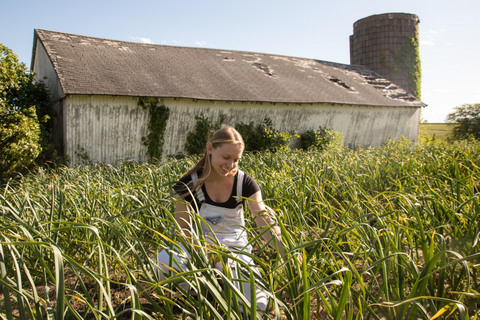
Ultra-Local Eating: Jennifer Miller Guides CSA, Iowa Food Cooperative
Jennifer Miller could hardly believe the question. “When will your bananas be ready?” inquired a central Iowa woman who was buying fresh produce through Miller’s Clarion Sage market garden and community supported agriculture (CSA) business near Waukee.
“People are disconnected from where their food comes from,” said Miller, 30, who noted the woman seeking locally-grown bananas is a well-educated business professional. “I’ve even had people look at our heirloom tomatoes and say, ‘I don’t want those,’ because they think they are GMOs.’”
This disconnect isn’t all that foreign to Miller, who grew up in Highland Park, Illinois, a northern suburb of Chicago. “I had no contact with agriculture in Highland Park,” said Miller, who serves as the Iowa Food Cooperative’s member services coordinator.
Miller did have a connection with Iowa, though, through her paternal grandparents, who lived in the Clarion/Rowan area. Her decision to move to Iowa in 2010 was spurred, in part, by a health challenge and new-found passion for healthy eating.
Miller was diagnosed a number of years ago with celiac disease, a serious autoimmune disorder where consuming gluten can damage the small intestine. “I started caring more about cooking and healthy recipes, because I just wanted to feel better,” said Miller, whose gluten-free and vegan recipes on her blog caught the attention of Martha Stewart Living editors, who invited her to develop recipes for them. “That’s what got me into food and agriculture.”
Food can be so much more interesting
After moving to Iowa, Miller got involved with community gardens in the Des Moines area and became a marketing/communications specialist Iowa Food Cooperative, which operates like an online farmers market. In 2013, Miller and her partner, Cody Kilgore, moved to an acreage on the southwest edge of Waukee’s city limits in Van Meter Township so they could operate their own farm.
“It felt like coming full circle,” said Kilgore, who was raised in rural Missouri, worked in the corporate world for nearly 30 years and was ready for a career switch.
 The couple planted garlic in the fall of 2013 to start their Clarion Sage market garden. The goal? “We believe in ultra-local and want to feed the community around us,” said Miller, who noted that Clarion Sage primarily serves families within a five-mile radius in southern Dallas County.
The couple planted garlic in the fall of 2013 to start their Clarion Sage market garden. The goal? “We believe in ultra-local and want to feed the community around us,” said Miller, who noted that Clarion Sage primarily serves families within a five-mile radius in southern Dallas County.
Today, Miller and Kilgore raise a wide array of vegetables and herbs, including lettuce, squash, cabbage, carrots, garlic, tomatoes, cucumbers, peppers, potatoes and more, including heirloom varieties that can’t be found in most stores. They offer an online ordering system for added convenience.
“Food can be so much more interesting,” Miller said. “Whether you’re sharing a family meal, providing snacks for your kids or making a favorite recipe, one thing’s for sure: the starting point for all these is good food.”
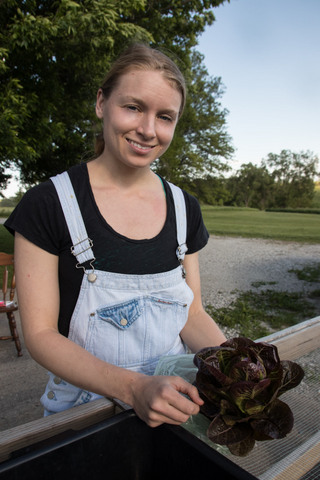
Jennifer Miller displays one of the unique lettuce varieties she grows at Clarion Sage Farm near Waukee.
Six lessons learned about farming and food
As their business evolved, Miller and Kilgore have adjusted their marketing plan to adapt to the often surprising—and sometimes frustrating—buying patterns they’ve observed in the market. The Clarion Sage market garden and CSA have taught them six key lessons, including:
1. Farming is more than production. Raising an abundant crop is just step one, said Miller, who has learned that that marketing and sales are equally important.
2. Mentors matter. “I didn’t grow up gardening, so working for various produce growers in Iowa and beyond taught me so much,” said Miller, who is grateful for leaders like Angela Tedesco who started Turtle Farm near Granger, Jill Beebout from Blue Gate Farm near Chariton and other local food proponents who have mentored her along the way.
3. Buying local adds flavor to life. Clarion Sage’s customers appreciate the “know your farmer” philosophy. Most buyers tend to be in their 30s and 40s with families, or they’re retired and have an interest in good food and time to cook. “Every week we offer our customers about $30 worth of fresh vegetables,” Miller said. “We focus on staple items like lettuce, potatoes, carrots and tomatoes, with the opportunity for more exotic options like stir-fry greens, kale and eggplant.”
4. Catering to consumers can be tricky. While the Clarion Sage CSA is right on Waukee’s doorstep, some consumers don’t want to drive to the farm to pick up vegetables. Some feel they don’t have time, while others don’t like the way the gravel road makes their vehicle dusty. When Miller tried offering delivery, some consumers still rejected this option, citing a lack of time or interest in preparing fresh food. Even full-color newsletters filled with cooking tips and recipes failed to gain much traction with these types of consumers, said Miller, who plans to start selling her produce at the Downtown Farmers’ Market in Des Moines.
5. Urban sprawl is relentless. High-density residential projects are planned for the area near the Clarion Sage’s market garden. “We’re in the bullseye of urban sprawl, which is a challenge,” said Kilgore, who also works as a wedding photographer.
6. Local food pairs well with global flavors. Miller loves ethnic cooking, from Latin American to African. “If you want to add more vegetables to your diet, look to other cultures that don’t have an abundance of meat protein,” said Miller, who encourages people to try vegetables like Cherokee Purple heirloom tomatoes (known for their smoky, complex flavor), fish peppers (which pack more heat), Merlot lettuce (whose dark red leaves offer a mellow flavor) and fingerling potatoes (which taste great fried or roasted).
Food is one of the best parts of life, added Miller, who loves the creativity involved in growing and marketing a crop. “You see a crop through from beginning to end, and you’re producing something that can feed and sustain people. That’s amazing to me.”
Want more?
Thanks for stopping by. I invite you to read more of my blog posts if you want more more intriguing Iowa stories and history, along with Iowa food, recipes and tips to make you a better communicator. If you like what you see and want to be notified when I post new stories, be sure to click on the “subscribe to blog updates/newsletter” button at the top of this page. Feel free to share this information with friends and colleagues who might be interested, too.
If you’re hungry for more stories of Iowa history, check out my top-selling “Culinary History of Iowa: Sweet Corn, Pork Tenderloins, Maid-Rites and More” book from The History Press, as well as my Calhoun County” book from Arcadia Publishing, which showcases the history of small-town and rural Iowa. Order your signed copies today! Iowa postcards are available in my online store, too.
Let’s stay in touch. I’m at darcy@darcymaulsby.com, and yettergirl@yahoo.com.
P.S. Thanks for joining me. I’m glad you’re here.
@Copyright 2017 Darcy Maulsby & Co.
About me:
Some people know me as Darcy Dougherty Maulsby, while others call me Yettergirl. I grew up on a Century Farm between Lake City and Yetter and am proud to call Calhoun County, Iowa, home. I’m an author, writer, marketer, business owner and entrepreneur who specializes in agriculture. Learn more at www.darcymaulsby.com.
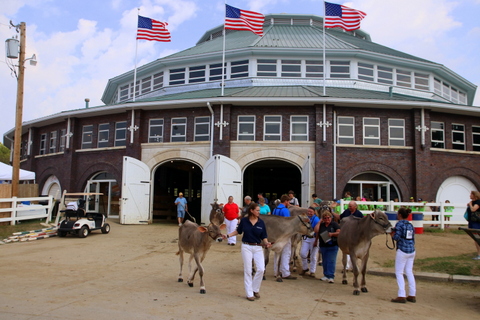
Iconic State Fair Architecture- Historic Buildings Reflect Decades of Memories
The Iowa State Fair is a homecoming for Iowans, and the historic buildings that grace the fairgrounds in Des Moines provide iconic venues for this statewide family reunion. There’s also a lot of surprising history behind many of these structures, from the Agriculture Building to the Livestock Pavilion.
“The Iowa State Fair connects generations of Iowans,” said Iowa Governor Kim Reynolds, who spoke during the opening ceremony of the 2017 Iowa State Fair on August 10. “There are so many wonderful memories and traditions here at the fair, which showcases the best of Iowa’s agricultural and cultural heritage.”
While the first Iowa State Fair was held October 25-27, 1854, in Fairfield, supported by a total operating budget of $323, the fair moved to its present location in 1886.
“The state fair moved to this site in Des Moines after the State Legislature and the City of Des Moines appropriated funds to purchase Calvin and Arminta Thornton’s farm,” said Leo Landis, state curator for the State Historical Society of Iowa, who helped lead an Iowa State Fair walking tour on Aug. 10. “One building original to the Thornton farm remains–Grandfather’s Barn, which is on the far eastern edge of the fairgrounds.”
Livestock Pavilion opened in 1902
Between the time the Fair Board purchased the land in June 1886 and when the fair opened in September 1886, crews constructed 67 buildings. “Of those, Pioneer Hall is the only one that remains today,” said Landis, museum curator at the State Historical Museum.
By the 1900 Iowa State Fair, most of the buildings built for the 1886 fair were still in use. They were beginning to show signs of decay, however, and roofs were particularly bad. It was time for the Iowa State Fair to clean up the fairgrounds.
One of the first new buildings added more than a century ago was the Livestock Pavilion. Back in 1901, more than 650 cattle were shown at the Iowa State Fair – only about 50 less than were shown that year at the International Stock Show at Chicago, Landis said. With future Iowa State Fairs expected to have even more cattle, the Iowa Legislature appropriated $37,000 for a fireproof steel-and-brick stock pavilion, similar to one that had just been constructed at the Illinois State Fairgrounds.
The Livestock Pavilion was the first major brick-and-steel structure built at the Iowa State Fairgrounds. “By constructing buildings out of these materials, the Fair Board gave the fair a sense of permanence and safety at this location,” said Landis, who noted that the new Livestock Pavilion officially opened for the 1902 fair and has been used for stock judging, lectures, entertainment and more for decades.

A new Agriculture Building was constructed in time for the 1904 Iowa State Fair. This famous building is home to the beloved Butter Cow. The Agriculture Building is one of the finest examples of Double Jeffersonian architecture remaining in the world.
1904 State Fair showcased new Agriculture Building
A new Agriculture Building came along two years later, in time for the 1904 Iowa State Fair. Located at the intersection of Grand Avenue and Rock Island Avenue, the Agriculture Building was built along the route to and from the State Fair from the Rock Island Railroad depot.
From the beginning, the Agriculture Building has been used as the agricultural, horticultural and dairy building. It’s home to the famous Butter Cow and other butter sculptures, which have been part of the Iowa State Fair since 1911.
“The Homestead,” a well-known farm newspaper of the late 1800s and early 1900s published in Des Moines, touted the new Agriculture Building as “one of the finest structures for exhibiting products of the farm that can be found in the Central West.”
The building’s design was inspired by the Exposition Halls at the Columbian Exposition, the world’s fair held in Chicago in 1893. The Agriculture Building is one of the finest examples of Double Jeffersonian architecture remaining in the world.
“Building a structure of such grand scale – with 33,800 square feet of floor space – suggested to visitors that the Iowa State Fair was an event of both civic and social importance,” said Jessica Rundlett, special projects and outreach coordinator at State Historical Museum of Iowa, who assisted with the Iowa State Fair walking tour.
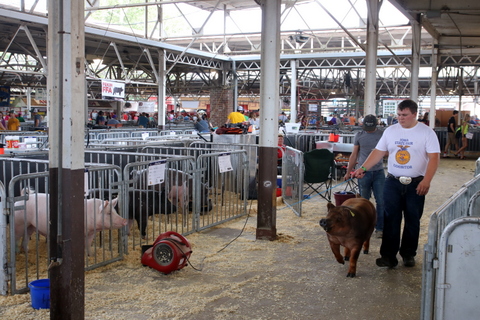
Kyle Andrews with the Wayne FFA chapter exhibited hogs during the 2017 Iowa State Fair. The Swine Barn was built in 1907.
Swine Barn design enhanced ventilation
When a new Swine Barn was constructed for the 1907 Iowa State Fair, the roof covered 185,000 square feet of stalls, exhibition areas and two central show rings that could seat more than 800 people. “The Homestead newspaper said you had to see it to believe its grand size,” Landis said.
The state appropriated $75,000 to build the Swine Barn. The building’s roof profile is designed to provide superior lighting and ventilation. The long open windows at roof level and open exterior walls draw in fresh air. Today you can see the Big Boar at the Swine Barn, as well as the Avenue of Breeds, which is coordinated by the North Polk FFA.
Horse Barn cost $25,000
The Horse Barn was completed in 1912 for $25,000 and renovated in 1929. Measuring 156 feet by 224 feet, the new barn could accommodate 132 draft horses and a like number of ponies, according to the Homestead newspaper. Th article also noted the new barn was equipped with water troughs, wash stands, sanitary feed mangers and automatic hayracks, Landis said.

The Horse Barn was completed in 1912 for $25,000 and renovated in 1929.
Cattle Barn named for Iowa farmer
The Iowa State Fair’s building boom of the early twentieth century included the new Cattle Barn, which opened for the 1914 fair. While the original barn could accommodate 108 head of cattle, the barn now has ties for 1,600 cows, thanks to multiple expansions through the years.
Among the early proponents of Iowa’s cattle industry was Iowa Governor William Larrabee of Clermont, Landis noted. Larrabee helped introduced Brown Swiss dairy cattle to Iowa after studying the breed and concluding Brown Swiss were best suited for Iowa’s climate.
Today, the Cattle Barn is named for John Putney, a farmer from Gladbrook who was also a long-time cattle exhibitor, president of the Sale of Champions and beef superintendent. Putney was appointed the first executive director of the Blue Ribbon Foundation, which has raised more than $135 million in the last 25 years to renovate and preserve the Iowa State Fairgrounds.
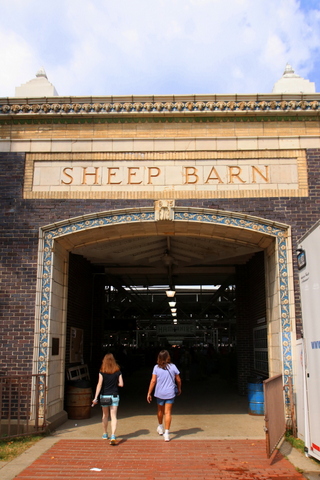
In 1915, the state legislature appropriated $14,000 to build a sheep pavilion. The Sheep Barn opened for the 1917 Iowa State Fair. The building is notable for the detailed terra cotta designs on the east façade, including a row of rams’ heads near the roof.
Sheep Pavilion opened for 1917 fair
During the Golden Age of Agriculture, state funding was available to construct a wide range of livestock barns at the Iowa State Fair. In 1915, the state legislature appropriated $14,000 to build a sheep pavilion. The Sheep Barn opened for the 1917 Iowa State Fair. The building is notable for the detailed terra cotta designs on the east façade, including a row of rams’ heads near the roof.
The legacy lives on
The Iowa State Fairgrounds was listed on the National Register of Historic Places in 1987. It’s a fitting honor for a unique venue filled with many architectural marvels. “The late Bill Wagner, a preservation architect from Iowa, noted that ‘the complex contains a representative collection of almost all architectural styles for most of the past 200 years,’” Landis said.
Historic buildings are just one of the many reasons the Iowa State Fair is the best state fair in the nation, Reynolds said. “I’m extraordinarily proud of this tradition. Remember—nothing compares to our great Iowa State Fair!”
Take a virtual tour
The Iowa State Fair Walking Tour can be found on the Iowa Culture App. Either download the app, or log onto dcaapp.com. Click on the featured tour “Star” button on the right and look for the “Iowa State Fair tour.”
Want more?
Thanks for stopping by. I invite you to read more of my blog posts if you want more more intriguing Iowa stories and history, along with Iowa food, recipes and tips to make you a better communicator. If you like what you see and want to be notified when I post new stories, be sure to click on the “subscribe to blog updates/newsletter” button at the top of this page. Feel free to share this information with friends and colleagues who might be interested, too.
If you’re hungry for more stories of Iowa history, check out my top-selling “Culinary History of Iowa: Sweet Corn, Pork Tenderloins, Maid-Rites and More” book from The History Press, as well as my Calhoun County” book from Arcadia Publishing, which showcases the history of small-town and rural Iowa. Order your signed copies today! Iowa postcards are available in my online store, too.
Let’s stay in touch. I’m at darcy@darcymaulsby.com, and yettergirl@yahoo.com.
P.S. Thanks for joining me. I’m glad you’re here.
@Copyright 2017 Darcy Maulsby & Co.
About me:
Some people know me as Darcy Dougherty Maulsby, while others call me Yettergirl. I grew up on a Century Farm between Lake City and Yetter and am proud to call Calhoun County, Iowa, home. I’m an author, writer, marketer, business owner and entrepreneur who specializes in agriculture. Learn more at www.darcymaulsby.com.


